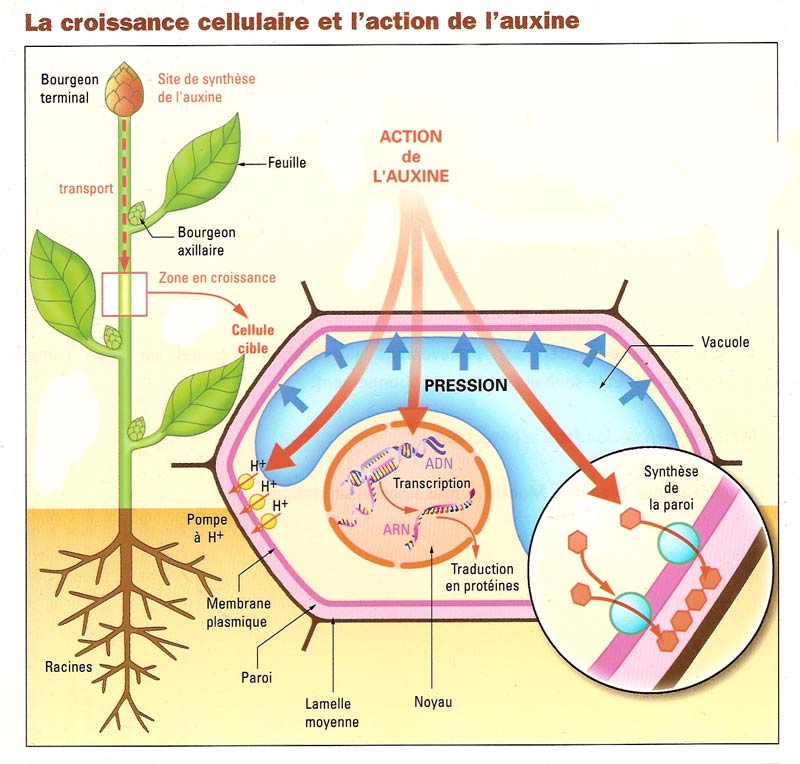Hormones are chemical signaling molecules present in very small quantities that regulate and control operations, functions and responses by feedback. They come from farmers, bodybuilders and other sports in the news. They inhibit or stimulate metabolism and growth (weight, height), aging (sexual) maturation, behavior, sensitivity to external influences (illness, mold...).
Also in other organisms life functions are tuned together by chemical control.
Plant hormones are produced mainly in the fast- growing areas, such as the tissue division in root tips, stem buds and young leaves. They regulate growth and development, and are less specific than animal hormones. They bind to (certain) (receptors of) cells and activate a specific change.
Many plant cells remain totipotent: an embryonic cell that has the ability to develop into any cell type. Plant hormones can steer those functions.
In addition, there is also a complex interaction. The one stimulates or suppresses the other. It is an area where a lot of research is to make yet to understand it a little.
There are six groups of plant hormones: auxins, gibberellins, cytokinin, abscisic acid, ethylene and brassinosteroids.
Auxin, or the growth hormone, is (relatively) the best known.
 Some known and important effects.
Some known and important effects.
Aixine stimulates the growth and direction of growth, including roots, keeps auxin producing leaves on the stem, avoids branching if the growing tip stays intact, seeks sun and a (leaf)green stem, controls the growth of fruits and the support for climbing plants.
Cells respond differently to various concentrations of auxin. A lying stem will produce more auxin at the bottom than at the top, so the bottom is growing faster and the stem stands up. Auxin is transported from the growing points and young leaves of the plant downwards, so that the stem is getting up or curves in the direction of light.
Cut one of the auxin -producing growing tip of a plant then the axillary buds respond by going forth (apical dominance) (and make sprouts/succers).
Auxins are used in rooting powder to encourage root making in cuttings or cut leaves. Also for the healing of wounds, the fruit set and fruit fall auxins are used.
Increased auxin levels at the right time and in the right place, result in better growth and more production. Fast growth is not synonymous with a strong and healthy plant. Auxins make certain parts of plants grow so explosively that the plant 's development has been disrupted. In Vietnam, they are used as a defoliant.
Willow branches shoot very easy to root. This is partly due to the high content of auxins in the cambium. Auxins which you could reap for other plants to boost them with. Cut willow branches in pieces, let draw 5-7 days in a bucket of water, and dilute with water 1:4.
Gibberellins have a growth regulating effect. Dwarf plants do not make it. In low concentrations it causes an increase in the dimensions. It is used to increase the yield of sugar cane, and the size of grapes. At high concentrations it causes uneven elongation (becoming longer). They stimulate the growth of buds and inhibit (in unusual places) adventitious root growth. They are used to obtain (celery, rhubarb, cotton) quicker and taller plants.
They break the tranquility of seeds. Gibberellic acid is used industrially in the malt industry where they shorten the malting process (germinating barley).
Cytokinin cares by the interaction with auxins for growth and differentiation in plants. In low concentrations, the cytokinins can stimulate cell division, especially with auxin. In high concentrations (1-10 mg / l), they stimulate the formation of adventitious shoots.
Abscisic acid suppresses the action of other plant hormones and is a natural growth inhibitor, that e.g. prepares for the winter (less cell division, leaf fall). CCC (Cycocel) is used for shortening cereal species.
Ethylene is an aging or maturing hormone that accelerates the fruit ripening and fruit coloring (tomato, banana) and promotes leaf fall. It shortens the vase life of cut flowers (so do not put flowers next to the fruit bowl). Dandelions separate ethylene, which makes green tomatoes will ripen.
Brassinosteroids stimulate the production of proteins and fatty acids, enhance the ability of the plant to capture energy from sunlight and promote the growth and resistance.
An extract of the sticky catchfly (Silene viscaria) has a high content of brassinosteroids and has a stimulating effect on the growth of other plants.
Jasmine acid sends immunity and plays an important role in directing immune responses against injury, ozone and herbivorous insects and is counted among the phytohormones, together with salicylic acid and brassinosteroids.
An tropy is a rotary motion in the growth, so that the plant grows away from or to a stimulus. This is caused by auxins, so that the plant, on the one side is shorter than on the other hand, and bends.
Depending on the type of stimulus, the word "-tropy " is preceded by a Greek prefix that indicates the type of stimulus that causes a movement or growth in response, e.g.
Chemotropie: (a movement or growth in response) to substances
Photo- on light
Geo- or gravitropie: gravity
Helio-: the sun (during the day leaves focus on the position of the sun, e.g. sunflower)
Hydro-: to moisture or water (especially in roots)
Thermo-: temperature
Thigmotropie: to touch or contact (e.g. up circling ivy)
